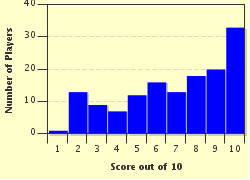Quiz Answer Key and Fun Facts
1. With an area large enough to make it the world's tenth largest country, Western Australia covers almost a third of the whole country. In which modern-day state or territory, Australia's second-largest, would you find Possession Island, where James Cook claimed Australia for Britain in 1770?
2. South Australia became a new British Colony in 1836 and Australians in that state still celebrate "Proclamation Day" annually on December 28. After the spouse of which British monarch is the state's capital named?
3. The cricket ground known as "The Gabba" was the site for a record-breaking England innings during the 2010 Ashes, with three batsmen, Alistair Cook, Jonathan Trott and Andrew Strauss all scoring centuries and Cook establishing a new test match record at the ground with his 235 not out. In which city is The Gabba?
4. Founded in Sydney in 1973, hard rock band AC/DC were the biggest Australian group ever to hit the music world. Which city, located on the natural bay of Port Phillip, was the birthplace of drummer Phil Rudd, the only Australian-born member of the band's classic line-up?
5. First held in 1861, it is described as "the world's richest two-mile handicap" and "the race that stops a nation". The 154th running of the Melbourne Cup in 2014 was a triumph for Anglo-German relations with an English jockey riding a German bred and trained horse to victory. At which racecourse is the annual jamboree held?
6. In 1973, Patrick White became the first Australian to win what?
7. Scene of the worst mass murder since Australia gained independence, Port Arthur is a former British penal settlement that is now a UNESCO World Heritage Site. In which Australian state or territory can you visit Port Arthur?
8. Who/what is/was the "Fremantle Doctor"?
9. Australia's highest point is named after the Polish national hero and notable figure in the American Revolution, General Tadeusz Kosciuszko. It was not always thus, though: with which of its close neighbors did Kosciuszko swap names in order to make it the highest?
10. First run in 1928, the Australian Grand Prix has been part of the Formula One circuit since 1985. It has been the traditional opening race of the F1 season since 1996, when it moved to its new home at Albert Park, in which city?
Source: Author
EnglishJedi
This quiz was reviewed by FunTrivia editor
Tizzabelle before going online.
Any errors found in FunTrivia content are routinely corrected through our feedback system.


